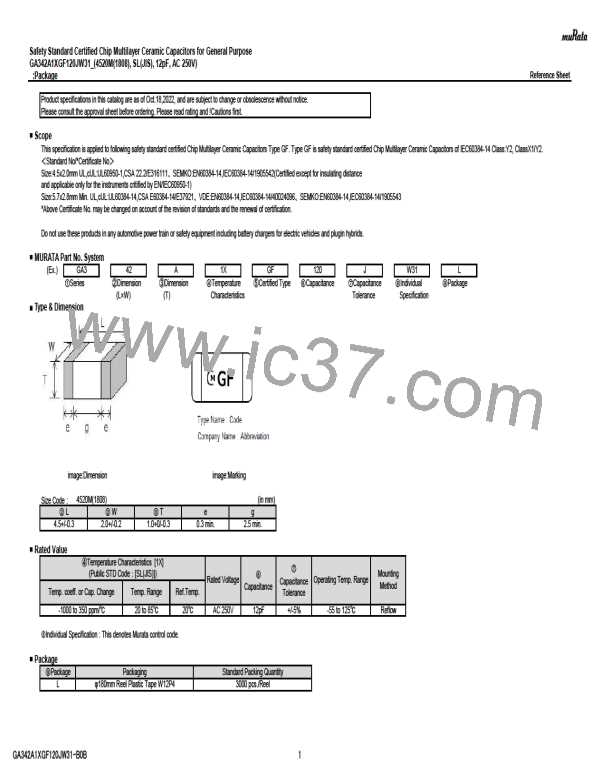4. Type of Applied Voltage and Self-heating Temperature
1. Confirm the operating conditions to make sure that no large current is flowing into the capacitor due to the continuous application of an AC voltage or pulse voltage.
ꢀ When a DC rated voltage product is used in an AC voltage circuit or a pulse voltage circuit, the AC current or pulse current will flow into the capacitor; therefore check the self-heating condition.
ꢀ Please confirm the surface temperature of the capacitor so that the temperature remains within the upper limits of the operating temperature, including the rise in temperature due to self-heating.
ꢀ When the capacitor is used with a high-frequency voltage or pulse voltage, heat may be generated by dielectric loss.
< Applicable to Temperature Characteristic X7R(R7) >
ꢀ1-1. The load should be contained so that the self-heating of the capacitor body remains below 20°C, when measuring at an ambient temperature of 25°C.
In addition, use a K thermocouple of ø0.1mm with less heat capacity when measuring, and measure in a condition where there is no effect from the radiant heat of other components or air flow caused by convection.
Excessive generation of heat may cause deterioration of the characteristics and reliability of the capacitor.
(Absolutely do not perform measurements while the cooling fan is operating, as an accurate measurement may not be performed.)
5. DC Voltage and AC Voltage Characteristic
1. The capacitance value of a high dielectric constant type capacitor changes depending on the DC voltage applied. Please consider the DC voltage characteristics when a capacitor is selected for use in a DC circuit.
ꢀ1-1. The capacitance of ceramic capacitors may change sharply depending on the applied voltage. (See figure) Please confirm the following in order to secure the capacitance.
(1) Determine whether the capacitance change caused by the applied voltage is within the allowed range .
(2) In the DC voltage characteristics, the rate of capacitance change becomes larger as voltageincreases, even if the applied voltage is below the rated voltage.
When a high dielectric constant type capacitor is used in a circuit that requires a tight (narrow) capacitance tolerance (e.g., a time constant circuit),
please carefully consider the voltage characteristics, and confirm the various characteristics in the actual operating conditions of the system.
2. The capacitance values of high dielectric constant type capacitors changes depending on the AC voltage applied. Please consider the AC voltage characteristics when selecting a capacitor to be used in an AC circuit.
6. Capacitance Aging
1. The high dielectric constant type capacitors have an Aging characteristic in which the capacitance value decreases with the passage of time. When you use a high dielectric constant type capacitors
in a circuit that needs a tight (narrow) capacitance tolerance (e.g., a time-constant circuit), please carefully consider the characteristics of these capacitors, such as their aging, voltage, and temperature characteristics.
In addition, check capacitors using your actual appliances at the intended environment and operating conditions.
7. Vibration and Shock
1. Please confirm the kind of vibration and/or shock, its condition, and any generation of resonance.
ꢀꢀPlease mount the capacitor so as not to generate resonance, and do not allow any impact on the terminals.
2. Mechanical shock due to being dropped may cause damage or a crack in the dielectric material of the capacitor.
ꢀꢀDo not use a dropped capacitor because the quality and reliability may be deteriorated.
3. When printed circuit boards are piled up or handled, the corner of another printed circuit board
ꢀꢀshould not be allowed to hit the capacitor in order to avoid a crack or other damage to the capacitor.
GA342A1XGF120JW31-B0B
12

 MURATA [ muRata ]
MURATA [ muRata ]